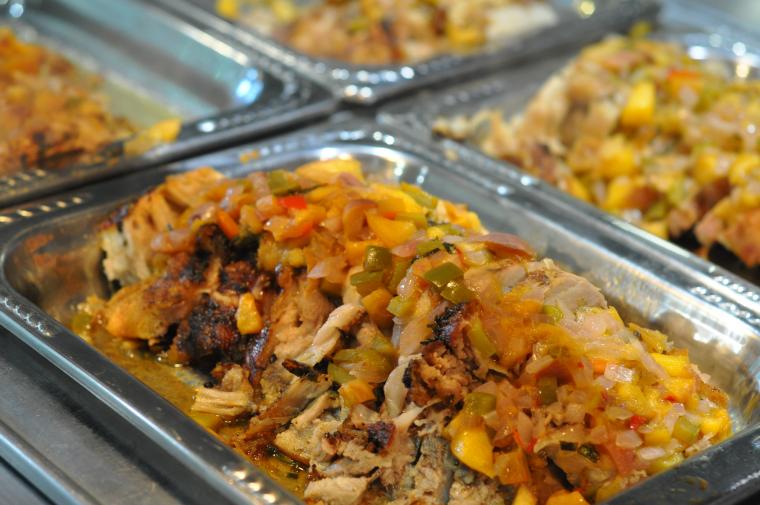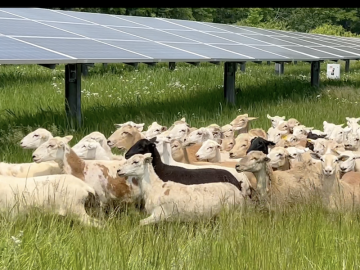Dining Service Celebrates Commitment to Local Food
October 10, 2013
Veronika Edwards

If you were wondering where that cut of bison bathed in mushroom demi-glace on your plate came from, you can rest assured that it was “local.” A facet of Oberlin College’s commitment to environmental sustainability, the food service provider Bon Appétit holds an annual Eat Local Challenge, a day devoted to raising awareness about the sources of prepared meals. Started in 2005, 100 percent of the ingredients in the Eat Local meal are from vendors within a 150-mile radius of where the food is served (excluding salt).
On September 24, the most recent Eat Local Challenge, faculty, staff, and students dining in Dascomb dining hall were offered a bison Salisbury steak topped with a mushroom demi-glace and roasted turnips with a stock of bison bones, while Stevenson dining hall served a pork loin roast with peach glaze, honey roasted butternut squash, and sautéed peppers. These meals were made with supplies from local sources, some as close as George Jones Farm in Oberlin.
Oberlin’s commitment to sustainability is expressed through its Sustainability Policy, which dictates that environmental preservation is considered in all actions taken by the College. Bon Appétit follows a parallel commitment to sustainability. With the launch of their Farm to Fork program in 1999, the company began returning 20 percent of purchases to the community through local farmers, artisans, ranchers, and businesses. The first of its kind, this initiative went nationwide in 2005, and Bon Appétit now has partnerships with more than 1,600 registered vendors as part of their Farm to Fork program.
Rick Panfil, the general manager of Bon Appétit at Oberlin, explains that the purpose of the Eat Local Challenge is to “celebrate local farmers, get to know people, and to start thinking outside of the supermarket box.” Bon Appétit provides incentives to raise awareness of this challenge, giving students the opportunity to win a Michael Pollan book or a $200 gift certificate when they took photos with their Eat Local Challenge meal and submitted them via social media.
At first, Panfil notes, the Eat Local Challenge was difficult to coordinate, requiring extensive research on the origin of every small ingredient in a meal—for example, Bon Appétit had to carefully consider where its yeast came from, an ingredient that can often slip one’s mind when considering eating local. Panfil notes that since 2005, the Challenge has become less strenuous, as Bon Appétit has established relationships with local farmers.
Now, Panfil explains, “the difficult part is getting the product to your back door.” In procuring the bison meat for this year’s meal, Bon Appétit had to personally pick up the bison from White Feather Farms in Pataskala, Ohio.
The Eat Local Challenge is a microcosm of Bon Appétit’s broader goal of buying local food. Bon Appétit purchases 27 percent of the ingredients that it uses on campus from local vendors such as Gibson’s Food Mart & Bakery and George Jones Farm, as well as from some Amish farmers in the area. The food service provider also takes vendors’ farming practices into consideration favoring those with sustainable practices such as integrative pest management and organic growth.
All in all, Panfil believes that the most important element of the Farm-to-Fork program is “getting to know farmers, and shaking their hands.” Building a healthy relationship with the agricultural community of Ohio is Bon Appétit’s priority, as it continues to increase its sources of local foods.
In addressing future goals, Bon Appétit works alongside Oberlin College students in a student-college initiative to increase “real food” in school cafeterias. “Real food” refers holistically to food that benefits not only consumers, but also producers, communities, and the Earth at large. By 2020, Bon Appétit hopes to guarantee 40 percent of the food it produces falls under that classification.
Tags:
You may also like…
Oberlin College & Conservatory Celebrates Black History Month
March 12, 2024
Oberlin’s Sustainable Infrastructure Program Enters Key Phase
May 30, 2023


